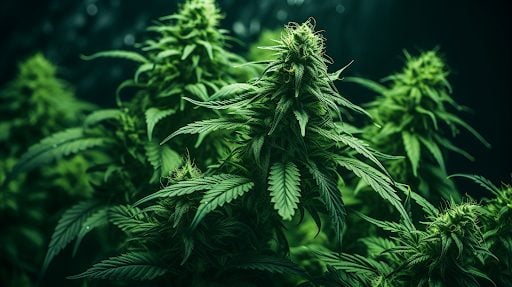Cannabis
What Exactly are Cannabinoids?
Cannabinoids are a diverse class of chemical compounds found within the cannabis plant. These compounds have garnered significant attention due to their potential therapeutic effects, as well as their psychoactive properties. In this article, we explain what cannabinoids are, the different types of cannabinoids, the distinction between cannabinoids and CBD, and the effects of cannabinoids on the human body.
What Are Cannabinoids?
Cannabinoids are a group of naturally occurring chemical compounds primarily found in the Cannabis plant. These compounds interact with the body’s endocannabinoid system, which plays a crucial role in regulating various physiological processes. The two most well-known cannabinoids are delta-9-tetrahydrocannabinol (THC) and cannabidiol (CBD), each with distinct effects.
While THC is responsible for the psychoactive “high” associated with cannabis, CBD is non-intoxicating and has gained attention for its potential therapeutic properties, including pain relief, anxiety management, and anti-inflammatory effects. Beyond THC and CBD, there are over a hundred other cannabinoids in cannabis, and ongoing research is uncovering their diverse properties and potential benefits in areas such as medicine and wellness.
The Cannabis Plant and Cannabinoids
Cannabis is a complex plant with a rich history of human use for medicinal, recreational, and industrial purposes. The two primary subspecies of the cannabis plant are Cannabis sativa and Cannabis indica. Both subspecies contain a wide variety of cannabinoids, but their concentrations can differ, leading to distinct effects.
Cannabinoids are cannabis extracts that are synthesized within the glandular trichomes of the cannabis plant, which are small, resin-producing structures found primarily on the flowering buds and, to a lesser extent, on the leaves. These trichomes produce a sticky resin that contains a rich mixture of cannabinoids and terpenes, which are responsible for the plant’s characteristic aroma and flavor.
The Endocannabinoid System (ECS)
The endocannabinoid system is a naturally occurring regulatory system within the human body. It is involved in a wide range of physiological processes, including pain perception, mood, appetite regulation, and immune function. The ECS consists of three main components:
- Endocannabinoids: These are naturally occurring compounds in the human body that are similar in structure to cannabinoids found in the cannabis plant. The two primary endocannabinoids are anandamide and 2-arachidonoylglycerol (2-AG).
- Cannabinoid Receptors: The ECS includes two main types of cannabinoid receptors: CB1 receptors, primarily located in the central nervous system, and CB2 receptors, primarily found in the peripheral tissues, especially in immune cells. These receptors are the key players in the ECS’s signaling process.
- Enzymes: Enzymes, such as fatty acid amide hydrolase (FAAH) and monoacylglycerol lipase (MAGL), are responsible for the synthesis and breakdown of endocannabinoids.
The Role of Endocannabinoids
Endocannabinoids, as the name suggests, are endogenous (naturally occurring) cannabinoids produced by the human body. They act as messengers within the ECS, binding to cannabinoid receptors to regulate various physiological functions.
The ECS helps maintain balance in the body, making it a crucial system for overall health. When there is an imbalance or disruption in homeostasis, the ECS can be activated to restore equilibrium. This is where exogenous cannabinoids, such as those from the cannabis plant, come into play.
Different Types of Cannabinoids
Cannabinoids can be classified into three main categories based on their origin: phytocannabinoids (plant-derived), endocannabinoids (naturally occurring in the human body), and synthetic cannabinoids (laboratory-created).
Phytocannabinoids
Phytocannabinoids are the most well-known group of cannabinoids, as they are found in the cannabis plant. Over 100 different phytocannabinoids have been identified, each with its unique properties and potential therapeutic effects. The most famous and extensively studied phytocannabinoids include:
- Tetrahydrocannabinol (THC): THC is the primary psychoactive ingredient in cannabis and is responsible for the “high” associated with marijuana use. It can also have various therapeutic effects, such as pain relief, appetite stimulation, and anti-nausea properties.
- Cannabidiol (CBD): CBD is another prominent phytocannabinoid, but it is non-psychoactive. It has gained significant attention for its potential therapeutic benefits, including pain management, anti-inflammatory effects, and potential use in various medical marijuana and cannabis products.
- Cannabinol (CBN): CBN is a degradation product of THC and is associated with sedative effects. It is often found in aged cannabis.
- Cannabigerol (CBG): CBG is considered the “stem cell” of cannabinoids because it is a precursor to other cannabinoids. It has potential anti-inflammatory and analgesic properties.
- Cannabichromene (CBC): CBC is non-psychoactive and has shown promise as an anti-inflammatory and analgesic compound.
- Tetrahydrocannabivarin (THCV): THCV is a lesser-known cannabinoid with potential appetite-suppressing effects and may have a role in weight management.
- Cannabidivarin (CBDV): CBDV is related to CBD and has shown potential as an anti-epileptic agent in preclinical studies.
Endocannabinoids
Endocannabinoids are cannabinoids produced naturally by the human body. The two primary endocannabinoids are anandamide and 2-AG. They are involved in various physiological processes, including mood regulation, pain perception, and immune function.
Synthetic Cannabinoids
Synthetic cannabinoids are a cannabinoid type that has been laboratory-created compounds designed to interact with cannabinoid receptors in a manner similar to phytocannabinoids. These compounds are often created for research purposes or to develop pharmaceutical drugs with specific effects. However, synthetic cannabinoids have been associated with adverse effects and are sometimes sold illicitly as designer drugs.
Are Cannabinoids the Same as CBD?
Cannabidiol (CBD) is a cannabinoid, but not all cannabinoids are the same as CBD. CBD is just one of many cannabinoids found in the cannabis plant, and each cannabinoid has unique properties and effects. The primary distinction between CBD and other cannabinoids, such as THC, lies in their psychoactive effects.
CBD vs. THC
- Psychoactive Effects: CBD is not psychoactive, meaning it does not produce a “high” or alter one’s state of mind. THC, on the other hand, is highly psychoactive and is responsible for the euphoria associated with marijuana use.
- Medical Applications: While both CBD and THC have potential medical applications, CBD is often preferred for its lack of psychoactive effects. It has been used in the treatment of conditions like epilepsy, anxiety, and chronic pain.
- Legal Status: The legal status of CBD varies by region, but it is generally more widely accepted and legally available than THC due to its non-psychoactive nature.
It is important to note that there are many other cannabinoids in addition to CBD and THC, each with its own set of effects and potential benefits. The decision to use a specific cannabinoid depends on the individual’s desired outcome and the condition being treated.
The Effects of Cannabinoids
Cannabinoids, whether of phytocannabinoid or synthetic origin, have a wide range of effects on the human body, primarily mediated through the endocannabinoid system and its cannabinoid receptors. These effects can vary depending on the specific cannabinoid, its dosage, and the individual’s unique physiology.
Pain Management
Cannabinoids, particularly THC and CBD, have shown promise as effective pain management tools. The endocannabinoid system plays a critical role in regulating pain perception. Activation of cannabinoid receptors, primarily CB1 receptors in the central nervous system, can modulate pain signals, providing relief to individuals suffering from chronic pain, neuropathic pain, or other painful conditions.
Appetite Regulation
Cannabinoids, particularly THC, are well-known for their ability to stimulate appetite. This effect, often referred to as the “munchies,” can be particularly beneficial for individuals dealing with appetite loss due to medical conditions or treatments like chemotherapy. In these cases, cannabinoids can help improve food intake and overall nutrition, contributing to a patient’s well-being.
Anti-Inflammatory Effects
Cannabinoids, especially CBD, have demonstrated anti-inflammatory properties. Inflammation is a key component of various diseases and conditions, including autoimmune disorders, arthritis, and chronic pain. By reducing inflammation, cannabinoids can potentially alleviate symptoms and improve the quality of life for individuals suffering from these conditions.
Cancer and Antitumor Effects
Cannabinoids have also been studied for their potential antitumor effects. Preclinical research suggests that cannabinoids, particularly THC and CBD, may inhibit the growth of cancer cells and induce apoptosis (cell death) in cancer cells. While more research is needed to establish the full extent of these effects, they offer hope for potential cancer treatments and therapies.
Adverse Effects
Despite the potential benefits, it’s important to acknowledge that cannabinoids can have adverse effects, particularly when used in excess or inappropriately. Some of the common negative effects associated with cannabinoid use include:
- Psychoactive Effects: The psychoactive properties of THC can lead to impaired cognitive and motor functions, altered perception of time, and feelings of anxiety or paranoia in some individuals.
- Addictive Potential: Some individuals may develop tolerance to cannabinoids, requiring higher doses to achieve the desired effects. This can lead to dependence and withdrawal symptoms when use is discontinued.
- Cannabis Use Disorder: Excessive and frequent use of cannabinoids, particularly THC, can lead to cannabis use disorder, characterized by dependence and negative consequences in various aspects of life.
- Cognitive Impairment: Long-term or heavy use of THC-containing products may lead to cognitive impairments, particularly in adolescents whose brains are still developing.
- Respiratory Issues: Smoking cannabis can lead to respiratory problems similar to those associated with smoking tobacco.
Buy Cannabis Products Online
Nupep Shrooms offers a wide range of high-quality cannabis products, catering to the diverse preferences of customers. From premium dried cannabis flowers to a variety of tinctures and vapes, our cannabis product selection ensures that consumers have access to a comprehensive spectrum of options.
Browse our selection of cannabis products
Frequently Asked Questions
What is the difference between CBD oil and cannabis oil, and how do their cannabinoid profiles vary?What is the role of endogenous cannabinoids, and how do they influence the activity of exogenous cannabinoids like Delta-9-THC?

